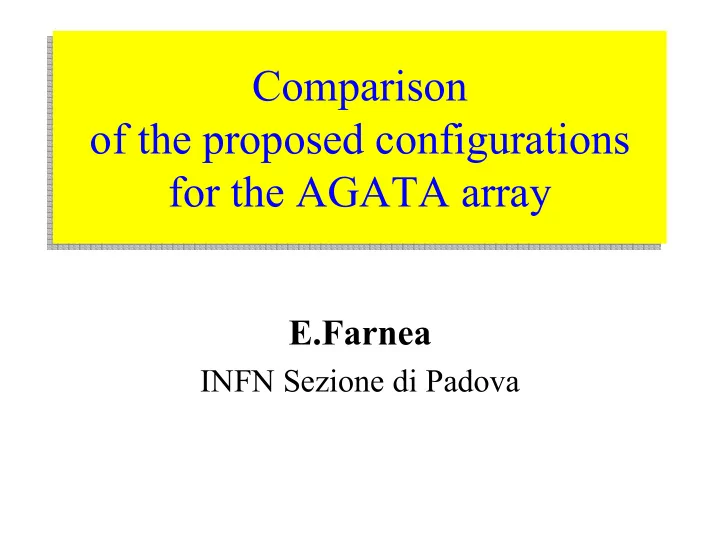

Comparison Comparison of the proposed configurations of the proposed configurations for the AGATA array for the AGATA array E.Farnea INFN Sezione di Padova
1. Geometries 1. Geometries 1. What kind of configurations are we considering? 2. Symmetries of the configurations and their implications on costs and performance
Geodesic Tiling of Sphere using 60–240 hexagons and 12 pentagons 60 80 110 120 150 200 240 180
Building a Geodesic Ball (1) Building a Geodesic Ball (1) Start with a On its faces, draw a regular platonic solid pattern of triangles grouped Project the faces on e.g. an icosahedron as hexagons and pentagons. the enclosing sphere; E.g. with 110 hexagons and flatten the hexagons. (always) 12 pentagons
Building a Geodesic Ball (2) Building a Geodesic Ball (2) Al capsules 0.5 mm spacing 0.7 mm thick Al canning 2 mm spacing 2 mm thick A radial projection of the spherical tiling generates Space for encapsulation and the shapes of the detectors. canning obtained cutting the Ball with 180 hexagons . Add encapsulation and crystals. In the example 3 part of the cryostats for crystals form a triple cluster realistic MC simulations
Symmetries Symmetries 1. The solid angle coverage is maximized only using irregular hexagons; with regular hexagons the performance of the array is lower because of the spaces between the crystals. 2. The maximal solid angle coverage for the A180 configuration is obtained with triple clusters (1 cluster, 3 detector shapes) 3. The same result for the A120 configuration can be obtained with quadruple clusters (1 cluster, 2 detector shapes) or with triple clusters (2 clusters, 6 detector shapes) 4. With 2 detector shapes and 1 kind of triple cluster, the A120 configuration has spaces between the crystals
2. The simulations 2. The simulations 1. The simulation process 2. Results
Event No experimental List-mode file: uncertainty! generation Agata -101 0.05005 -0.00000 -0.00056 1.00000 + -102 0.466 -1.660 0.000 -1 993.359 -0.48689 -0.86533 -0.11889 36 detector 131 150.495 -12.660 -26.164 -3.122 40 132 155.894 -10.057 -25.571 -1.729 34 response 132 1.402 -10.088 -25.595 -1.801 34 mgt Packing/smearing + Analysis of the spectra γ -ray tracking Root, xtrackn
Two candidate configurations Ge crystals size: Length 90 mm Diameter 80 mm 120 hexagonal crystals 6 shapes 180 hexagonal crystals 3 shapes 40 triple-clusters 2 shapes 60 triple-clusters all equal Inner radius (Ge) 18 cm Inner radius (Ge) 24 cm Amount of germanium 225 kg Amount of germanium 374 kg Solid angle coverage 78 % Solid angle coverage 79 % 4320 segments 6480 segments Efficiency: 37% (M γ =1) 22% (M γ =30) Efficiency: 39% (M γ =1) 25% (M γ =30) Peak/Total: 53% (M γ =1) 44% (M γ =30) Peak/Total: 53% (M γ =1) 46% (M γ =30)
Comparison of various configurations - 1 A120G, A120F : triple clusters A120C4 : quadruple clusters A180 : triple clusters Ge crystals size: length 90 mm, diameter 80 mm Passivated areas: 1 mm at the back and around the coaxial hole A120G A120F A120C4 A180 Number of crystals 120 120 120 180 Number of crystal shapes 2 6 2 3 Number of cluster types 2 2 1 1 Amount of germanium (kg) 232 225 230 374 Initial mass (kg) 289 289 289 434 Fractional loss (%) 19.7 22.1 20.4 13.8 Inner space radius (cm) 19.2 17.5 18.0 24.0 Solid Angle (%) 71 78 78 79
Comparison of various configurations - 2 A120G, A120F : triple clusters A120C4 : quadruple clusters A180 : triple clusters Ge crystals size: length 90 mm, diameter 80 mm Passivated areas: 1 mm at the back and around the coaxial hole A120G A120F A120C4 A180 Number of crystals 120 120 120 180 Electronics channels 4440 4440 4440 6660 Solid Angle (%) 71 78 78 79 ε ph / PT at M = 1 (%) 33 / 53 37 / 53 37/52 39 / 53 ε ph / PT at M = 30 (%) 21 / 45 22 / 44 22/44 25 / 46 Efficiency and P/T values at E γ = 1 MeV and recoil velocity β = 0. Values obtained after tracking with standard position resolution (5 mm @ 100 keV). Cryostats and capsules included in the simulation.
Photopeak efficiency Photopeak efficiency 30 photon rotational cascade E γ = E 0 +n ∆ E γ Recoil velocity β = 0
Effect of the recoil velocity - 1 Effect of the recoil velocity - 1 Photopeak efficiency 30 photon rotational cascade E γ = E 0 +n ∆ E γ A180 configuration (no scattering chamber) Recoil direction: z axis β : constant (event by event) Recoil velocity perfectly known when recostructing
Effect of the recoil velocity - 2 Effect of the recoil velocity - 2 1 MeV single photons, recoil velocity perfectly known when recostructing. Passivated areas, cryostats and capsules are considered. Reconstructed FWHM – Reconstructed FWHM – β =10% β =50%
Conclusions Conclusions 1. The full A180 array has superior performance than the A120 configuration(s) 2. The major advantage of the A180 configuration is the larger source-detector distance, implying a lower hit density and a more efficient tracking process 3. The A120F configuration has reasonable performance.
Recommend
More recommend